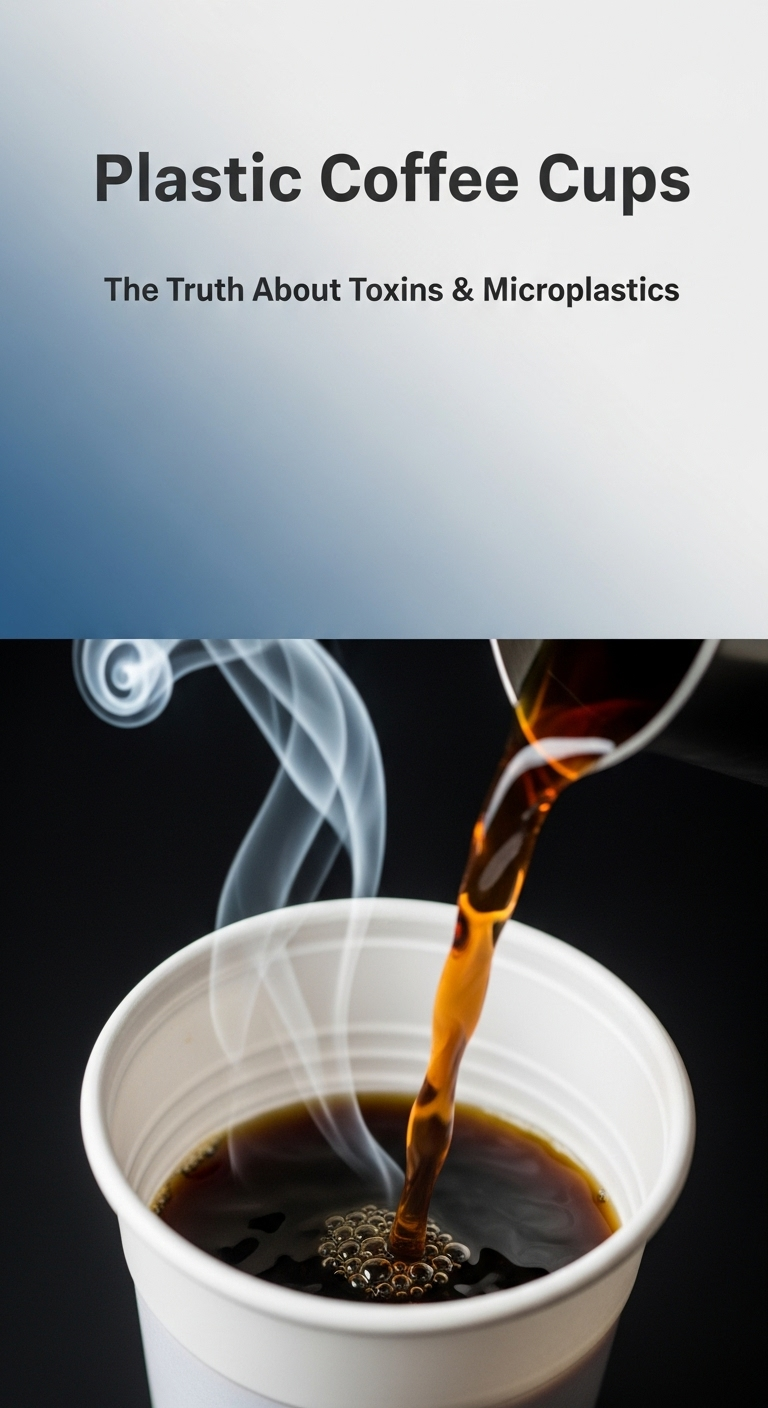As an Amazon Associate CoffeeXplore.com earns from qualifying purchases.
Plastic Coffee Cups: The Truth About Toxins & Microplastics
That comforting morning coffee you grab on the way to work might come with more than just a caffeine boost. You hold the warm cup, but a nagging question lingers: is it truly safe to drink hot liquids from plastic? With so much conflicting information, it’s difficult to know what to believe. You worry about chemicals, microplastics, and whether “BPA-free” is just a marketing gimmick.
The safety of plastic coffee cups depends heavily on the type of plastic used. While some plastics like polypropylene (PP) are designed to handle hot liquids, many can leach harmful chemicals and microscopic plastic particles when heated, posing potential health risks.
This guide cuts through the noise. Leveraging extensive analysis of scientific data, we will unpack the real risks associated with your daily disposable cup. We’ll explore the specific toxins involved, reveal the surprising truth about microplastics in both plastic and paper cups, and provide clear, actionable guidance on the safest alternatives for your health and the environment.
Key Facts
- Massive Microplastic Release: A single disposable cup can shed an average of 25,000 microplastic particles into a hot beverage in just 15 minutes, according to published studies.
- Hidden “Forever Chemicals”: Many cups, including paper ones, are lined with PFAS (“forever chemicals”) to make them waterproof. These chemicals are linked to metabolic, immune, and fertility problems and can leach into your drink.
- “BPA-Free” Isn’t a Guarantee: Even when a cup is labeled “BPA-free,” evidence suggests that other potentially harmful chemical compounds can still leach out when the plastic is heated.
- Paper Cups Share the Risk: The thin plastic lining in most paper coffee cups, designed to prevent leaks, breaks down with heat, releasing the same microplastics and chemicals found in all-plastic cups.
- Staggering Environmental Waste: The environmental toll is immense. In the UK alone, 2.5 billion coffee cups are thrown away each year, with each single-use cup contributing approximately 0.11 kg of CO2 equivalent to greenhouse gas emissions.
The Core Question: Are Plastic Coffee Cups Safe for Hot Drinks?
The safety of plastic coffee cups depends heavily on the type of plastic. While some plastics like polypropylene (PP) are designed for hot liquids, many can leach harmful chemicals when heated, posing potential health risks. Ever notice your plastic cup feeling a bit soft with that hot coffee in it? Here’s what’s really happening. The current scientific consensus is that heated plastics will definitely leach some quantity of chemicals into your food and drink. The heat from your coffee accelerates this process, breaking down the chemical bonds in the plastic and allowing them to migrate directly into your beverage.

The risk level varies significantly based on the material. Here’s a quick breakdown of common plastics used:
- Polypropylene (PP): Generally considered one of the safer plastics for hot beverages due to its high melting point. It’s often used for reusable plastic coffee cups.
- Polyethylene Terephthalate (PET): Typically used for cold beverage bottles. It is not designed to withstand high temperatures and can leach chemicals when heated.
- Polystyrene (PS or Styrofoam): This lightweight plastic is a poor choice for hot drinks. It is made from known carcinogens like benzene and styrene, which can leach out when exposed to heat.
The key takeaway is simple: not all plastics are created equal. While some are engineered to be more stable, the fundamental interaction between heat and plastic means there is always a potential for some level of chemical transfer.
What Harmful Chemicals Are Leaching Into Your Coffee?
Plastic coffee cups can leach chemicals like BPA and phthalates, linked to hormonal issues, and PFAS (“forever chemicals”), associated with metabolic and immune problems. Even BPA-free plastics can release other compounds, and some cups may contain trace heavy metals. The convenience of a disposable cup comes at a hidden cost. When you pour hot coffee into one, you may be creating a chemical cocktail. This isn’t just a single “bad” chemical; it’s a family of compounds that can disrupt your body’s normal functions.
Quick Fact: Some cups contain ‘forever chemicals’ (PFAS) designed to be waterproof, but they don’t break down in the environment or your body.
Here is a clear breakdown of the primary chemical threats you should be aware of and their documented health risks:
| Chemical | Potential Health Risks |
|---|---|
| Bisphenol A (BPA) & Phthalates | Known endocrine disruptors that can interfere with hormones, leading to reproductive problems, developmental issues, and increased risk of certain cancers. |
| PFAS (“Forever Chemicals”) | Associated with a range of health issues, including metabolic diseases, fertility problems, and negative impacts on the immune system. They accumulate in the body over time. |
| Microplastics & Nanoplastics | Can disrupt the immune system, alter metabolism, and cause reproductive toxicity. Nanoplastics are small enough to penetrate cells and have been found in blood and placentas. |
| Styrene & Benzene | Found in polystyrene (Styrofoam) cups. Both are classified as carcinogens and can leach into hot or acidic liquids. |
| Heavy Metals | Trace amounts of lead, chromium, and cadmium have been detected in liquids from disposable cups. Chronic exposure, even at low levels, can be toxic. |
The Truth About “BPA-Free” Plastics
While many cups are now “BPA-free,” this label does not guarantee safety, as other potentially harmful chemicals can still leach into hot beverages.
You’ve seen the “BPA-Free” label everywhere, and it feels like a safe choice. Unfortunately, it’s often a case of “out of the frying pan, into the fire.” To replace BPA, manufacturers often use other bisphenol compounds, such as BPS or BPF. The problem? Well-established research indicates that these substitutes can have similar hormone-disrupting effects.
The critical point to understand is that other chemicals can still leach out from these plastics. A “BPA-free” sticker tells you nothing about the presence of phthalates, PFAS, or other compounds used in the manufacturing process. It’s a specific claim that can create a false sense of overall security. Therefore, while avoiding BPA is a good first step, it doesn’t eliminate the underlying issue of chemical leaching from heated plastic.
The Invisible Threat: How Many Microplastics Are in a Single Cup?
A single disposable cup can release 25,000 microplastic particles into a hot beverage in just 15 minutes. These tiny particles can be ingested and have been found in human blood, lungs, and placentas, with potential health effects including immune disruption and reproductive toxicity.
Beyond the chemical soup, there is a physical contaminant that is even more pervasive: microplastics. These are tiny plastic fragments, smaller than a sesame seed, that break off from the cup’s lining when exposed to hot liquid. Even smaller particles, known as nanoplastics, can also be released, which are concerning because their size allows them to penetrate human cells and organs more easily.
According to one of the most cited studies in this field, a single 100 ml paper cup can release an average of 25,000 microplastic particles into hot water within just 15 minutes.
The process of ingestion is straightforward and alarming:
- Heat Exposure: You pour hot coffee or tea into the cup.
- Lining Degradation: The heat causes the thin inner plastic lining (present in both plastic and paper cups) to degrade and shed microscopic particles.
- Contamination: These thousands of microplastic and nanoplastic particles become suspended in your drink.
- Ingestion: You drink your beverage, consuming the plastic particles along with it.
- Accumulation: Evidence suggests these particles can accumulate in the body, with researchers finding them in human lung tissue, bloodstreams, and even placentas.
Pro Tip: While it won’t eliminate the risk, the data notes that washing plastic cups before use could reduce the initial release of loose microplastic particles from the surface.
The Paper Cup Paradox: Are They a Toxic Nightmare, Too?
No, paper coffee cups are often not safer. Their thin plastic lining, necessary to prevent leaks, can release thousands of microplastics and toxic “forever chemicals” (PFAS) into your hot drink, making them just as potentially harmful as conventional plastic cups.
Thought you were making a safer choice with paper? Let’s look at what holds that paper cup together. To prevent a hot, wet mess, paper cups must be coated on the inside with a thin, waterproof layer. That layer is almost always plastic—typically polyethylene.
This creates a “best of neither world” scenario. You are still exposed to the primary risks of a plastic cup while thinking you’ve chosen a healthier alternative. Here are the core issues with paper cups:
- The Plastic Lining is the Problem: It’s not the paper itself but the plastic film laminated to it that poses the health risk. When hot liquid hits this lining, it degrades just like any other plastic.
- Massive Microplastic Release: As mentioned, studies confirming the release of 25,000 microparticles were performed on these lined paper cups. You are ingesting plastic from them.
- Potential for “Forever Chemicals” (PFAS): To improve grease and water resistance, some of these linings are treated with per- and poly-fluoroalkyl substances (PFAS). These toxic chemicals can leach into your coffee and are known for their persistence in the human body and the environment.
So, when you choose a paper cup, you’re not avoiding plastic; you’re just consuming it in a different package.
Beyond Health: The Environmental Impact of Single-Use Coffee Cups
The environmental toll is massive: billions of non-recyclable cups end up in landfills annually, and the lifecycle of a single disposable cup generates approximately 0.11 kg of CO2 equivalent in greenhouse gases.
The question of whether are plastic coffee cups safe extends beyond personal health to the health of our planet. The convenience of a grab-and-go coffee has created an environmental crisis fueled by single-use cups, whether they are made of plastic or plastic-lined paper.
- Landfill Waste: The sheer volume is staggering. Billions of these cups are discarded globally every year. Data shows that in the UK alone, approximately 2.5 billion coffee cups are thrown away annually. This contributes significantly to overflowing landfills.
- Non-Recyclability: Did you know? Most disposable coffee cups can’t be recycled in standard facilities because the plastic lining is too difficult and costly to separate from the paper fiber. As a result, the vast majority end up incinerated or in a landfill.
- Greenhouse Gas Emissions: The damage starts long before you throw the cup away. The manufacturing process, from extracting raw materials (oil for plastic, trees for paper) to production and transportation, is energy-intensive. Numerous studies have shown that the carbon footprint of a single disposable cup is around 0.11 kg of CO2e.
Every time you use a disposable cup, you are contributing to a linear model of consumption—take, make, dispose—that has profound and lasting negative consequences for the environment.
What Are the Safest & Healthiest Coffee Cup Alternatives?
The safest materials for coffee cups are inert options like glass, ceramic, and stainless steel, which do not leach chemicals when heated. For plastic, polypropylene (PP) is a safer choice for hot drinks, and any reusable plastic cup should be certified BPA-free.
After learning about the risks, the next logical step is to find a truly safe solution for your daily coffee. The best choices are materials that are stable, non-reactive, and designed for long-term reuse. This not only protects your health but also drastically reduces your environmental footprint.
Here is a comparison of the best and safest alternatives available:
| Material | Safety with Heat | Chemical Leaching | Reusability |
|---|---|---|---|
| Glass | Excellent | None. Glass is inert and will not leach any chemicals or flavors. | High |
| Ceramic | Excellent | None. Like glass, ceramic is inert and a very safe option. | High |
| Stainless Steel | Excellent | None, when using food-grade stainless steel (e.g., 18/8 or 304). | Very High |
| Polypropylene (PP) | Good | Considered the safest plastic for heat; resistant to leaching. | High (for reusable versions) |
When choosing a reusable cup, here’s what to look for to ensure you’re making the safest choice. Industry analysis often indicates that focusing on certified, reputable products is key. Look for cups that are explicitly marked as BPA-free and made by a certified manufacturer. If you opt for a reusable plastic cup, ensure it is made from polypropylene (PP), which is the industry standard for heat-resistant food containers.
Your Turn: Based on this, which reusable cup material best fits your daily routine?
For those ready to make the switch to a safer and more sustainable option, investing in a high-quality reusable coffee cup is the most effective solution. To simplify your search, we’ve curated a selection of top-rated choices that prioritize health and durability.
FAQs About are plastic coffee cups safe
Here are direct answers to some of the most common questions people have about the safety of plastic coffee cups.
What is the absolute safest material for coffee cups?
Glass and ceramic mugs are considered the safest options as they are chemically inert and do not leach materials or flavors into hot beverages. These materials do not react with heat or acidic liquids like coffee, ensuring that you are only tasting your drink, not unwanted chemicals. Stainless steel is also an excellent and highly durable choice.
Are reusable plastic coffee cups really safe?
Yes, reusable plastic coffee cups can be safe if they are explicitly marked BPA-free, designed to be microwave-safe (indicating heat resistance), and made by certified, reputable manufacturers. Look for cups made from polypropylene (PP, recycling #5), which is widely recognized as a safer plastic for use with hot foods and beverages.
Which type of plastic is best for hot drinks?
Polypropylene (PP) is generally the safer plastic choice for hot beverages due to its higher melting point and better resistance to chemical leaching compared to other plastics. Always check the bottom of a plastic container for the recycling number; PP is labeled with a #5. Avoid using plastics not intended for heat, such as PET (#1).
Do all plastic cups leach chemicals when heated?
The scientific consensus is that virtually all plastics will leach some quantity of chemicals when heated. The type and amount of chemicals depend on the specific plastic and the temperature. Safer plastics like polypropylene are more stable, but the fundamental principle remains: heat increases the potential for chemical migration from plastic into food and drink.
Can you get microplastics from paper cups too?
Yes. The thin plastic lining inside paper cups degrades when exposed to hot liquids, releasing thousands of microplastic particles into the beverage. This hidden plastic layer means that a paper cup is not an effective way to avoid ingesting microplastics from your daily coffee.
Final Summary: Making a Safer Choice for Your Daily Coffee
The truth about plastic coffee cups is clear: the convenience they offer comes with significant and well-documented risks to both your health and the environment. From chemical leaching of endocrine disruptors to the invisible threat of microplastic ingestion, the daily use of single-use cups is a habit worth reconsidering. Even the seemingly innocent paper cup is often a Trojan horse, lined with the very plastics you may be trying to avoid.
Armed with this knowledge, you can now confidently choose a coffee cup that protects both your health and the environment. By understanding the materials and their properties, you can break free from the disposable cycle.
- Prioritize Inert Materials: The safest and healthiest choice is to switch to a reusable cup made of glass, ceramic, or food-grade stainless steel.
- Understand Plastic Labels: If you use plastic, choose reusable options made from polypropylene (PP) and ensure they are certified BPA-free by a reputable source.
- Avoid All Single-Use Cups: Both plastic and plastic-lined paper cups contribute to chemical exposure and environmental pollution. The best decision is to avoid them entirely.
Make the switch today. Investing in a high-quality, reusable coffee cup is a simple, powerful step toward a healthier lifestyle and a healthier planet.
Last update on 2025-12-05 / Affiliate links / Images from Amazon Product Advertising API

